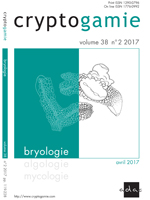In order to better understand the influence of short elevational gradient on the attributes of bryophyte communities, we examined the bryophyte flora within six elevational belts (10, 50, 400, 800, 950, and 1170 m a.s.l.) on a mountain in the Atlantic Forest in southeastern Brazil. Ten subplots (10 × 10 m) distributed randomly in 1 ha forest plot of forest at each elevation were surveyed. A total of 253 species were encountered and the richness did not vary depending significantly on elevation. The floristic similarities of the elevational belts were high > 50%, with the exception of the Mountaintop forest (< 35%), and the classification analyses indicated groups defined by Atlantic Forest vegetation types. Endemism demonstrated a positive correlation with elevation, while the amplitudes of the phytogeographical patterns of the species diminished with increasing elevation. The dioicous condition predominated in all of the elevational belts, and the dioicous/monoicous ratio showed an inverted-parabolic pattern along the gradient. Data concerning bryophyte species richness and distributions will be useful in future projects monitoring the effects of climate change on tropical forests.
How to translate text using browser tools
1 April 2017
Variations in Bryophyte Communities in a Short Elevational Gradient in Atlantic Forest of Southeastern Brazil
Nivea Dias dos Santos,
Denise Pinheiro da Costa,
Luiza Sumiko Kinoshita,
George Jonh Shepherd
ACCESS THE FULL ARTICLE
It is not available for individual sale.
This article is only available to subscribers.
It is not available for individual sale.
It is not available for individual sale.

Cryptogamie, Bryologie
Vol. 38 • No. 2
April 2017
Vol. 38 • No. 2
April 2017
Endemism
phytogeographic pattern
sexual system
tropical forest




